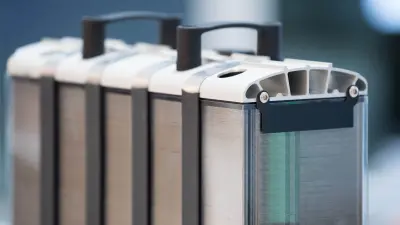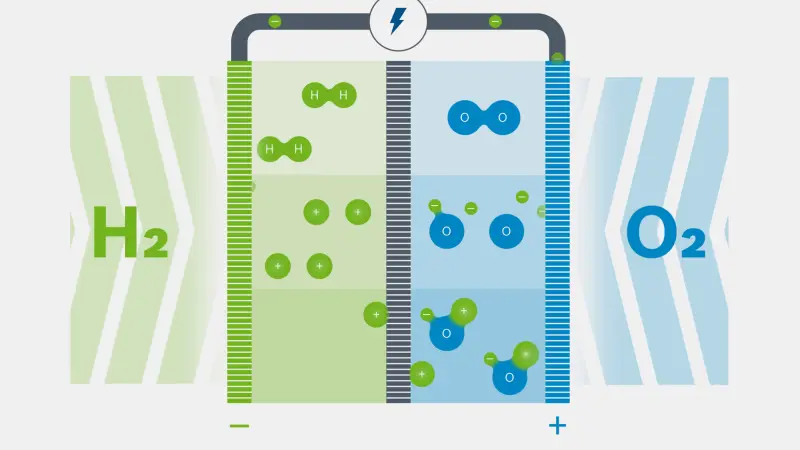Fuel-cell stacks: the recipe for success in mass manufacturing

What’s the winning formula for making fuel-cell stacks? Bosch has joined forces with the startup PowerCell Sweden to put this technology into mass production — and usher in its breakthrough.
Fuel-cell technology’s vast potential
On the surface of it, there’s very little to distinguish a fuel-cell car from one that runs on gasoline or diesel. Once its fuel has been topped up — which takes just a few minutes — the car’s range is over 500 kilometers. But there is one crucial difference: an electrical powertrain produces zero local emissions. And that’s why hydrogen technology is sure to figure prominently on the road to low-carbon transportation, especially when it comes to electrifying heavy trucks. But before fuel-cell vehicles can rival conventional ones, there is still one big obstacle to surmount: steep manufacturing costs. Bosch and the startup PowerCell Sweden aim to solve that problem. To bring costs down, the two companies are focusing their attention on the fuel-cell stack, the heart of the hydrogen powertrain. This stack of proton-exchange membrane fuel cells (PEMFC) — also known as polymer electrolyte membrane (PEM) fuel cells — is where an electrochemical exchange of the reactant gases hydrogen and oxygen produces electricity.


H₂
Hydrogen serves as the fuel. In the fuel cell, hydrogen molecules are on the anode side. They are made up of electrons and protons.
“Collaborating with Bosch will allow us to rapidly ramp up our technology for industrial-scale production.”
What matters most in mass manufacturing
A single fuel cell generates just a small amount of power, which is why engineers stack them in layers separated by bipolar plates. In a passenger car, putting roughly 400 fuel cells together will produce up to 120 kilowatts of power output (163 horsepower). For the higher power requirements of commercial vehicles, the number of stacks can be increased accordingly. The Bosch product manager Achim Moritz is reluctant to reveal too much about the specifics of containing fuel-cell and stack costs. But he will say this much: “One important approach is to use less expensive materials. We also expect to make further progress in other areas, for example by increasing the power output of individual cells.” He adds that the cost of a stack could be significantly reduced as unit numbers go up in large production runs.
However, manufacturing a system as complex as a fuel-cell stack on a massive scale is no easy task. “Each individual stack has to perform reliably. The control units therefore play a key role in vehicle operation,” Moritz says. Much like the engine control units in gasoline- and diesel-driven cars, these powerful mini-computers manage all the fuel cell’s functions and keep the powertrain operating as efficiently as possible. This is where Bosch is well ahead of the game. The company has been developing ECUs for many years. “With a great deal of in-house expertise and experience in this area, we can take advantage of these synergy effects for fuel-cell stacks. This helps in things like the modular design of the hardware kit and the control logic that are characteristic of such control units,” Moritz says.
Fuel-cell stacks look like this

O₂
Oxygen is the reactant. In the fuel cell, this is on the cathode side.
A proton exchange membrane separates O₂ and H₂, and the cathode and anode. It is permeable only to the protons in the hydrogen molecules.
This is what happens in a fuel-cell stack

The head start that comes with experience
What are the obstacles impeding progress on the path to reliable mass manufacturing? A closer look at this technology provides a better picture of the challenges inherent in making fuel cells. Hydrogen molecules are small in size and have low viscosity, which means the stack has to have a perfect seal to operate efficiently and safely. As Moritz points out, “The length of a 120 kW stack’s seal comes to around one kilometer. This is an area in which we’re striving to meet the demanding quality requirements for automotive applications.” In work on other types of powertrain, Bosch has already demonstrated that its experts have a wealth of experience and skills in developing products and processes in parallel — in simultaneous engineering, in other words. The ability to preselect the appropriate manufacturing method for components while designing a product — in other words, to always think a step ahead — is part of this.
“Simultaneous engineering is one of our USPs,” Moritz says. Per Wassén seconds that notion: “Bosch is the leading supplier of automotive technology and has vast experience and innovative strength in this area. The automotive sector is dominated by big international corporations and characterized by long development lead times and stringent quality requirements. No matter how technologically advanced it may be, a startup like PowerCell is going to find it difficult to tap this enormous market potential on its own. By collaborating with Bosch, we’ll help our technology achieve a breakthrough that much faster,” the CEO of PowerCell Sweden says.
2H₂+O₂ → 2H₂O
The byproduct is water. It’s the result of hydrogen ions — that is, protons — reacting with oxygen in a process accelerated by a catalyst within the fuel cell.
Filling up by the kilo instead of by the liter

DC
Fuel cells are designed to produce direct current (DC).
It’s created by conducting the hydrogen electrons through the anode, where they make their way through the external circuit and return to the cathode.
An inverter then converts DC into the alternating current (AC) that powers the electric motor.
As companies such as Bosch and PowerCell press ahead with their efforts to mass-manufacture mobile fuel cells, market forces are eroding a further obstacle impeding this technology’s adoption: availability. In many countries, the number of hydrogen filling stations is already on the rise. Subsidies account for some of this infrastructure expansion, but associations such as the Hydrogen Council are also lobbying to promote this development. “We are focusing on the markets in China, North America, and Europe, where we can see growing willingness on the part of industry to adopt fuel cell-electrical powertrains,” Moritz says.
Such a positive attitude comes from the realization that the path to emissions-free mobility has to reflect an open-minded approach. Just as the gasoline and diesel variants of combustion engines are constantly being improved, the electromobility side is seeing purely battery-electrical powertrains and fuel cells being developed side by side. Bosch has already made this technology neutrality its own, with the result that these innovative fuel-cell stacks are expected to come off the production lines at its Bamberg plant as early as 2022.
“We see an opportunity to significantly reduce costs once production volumes rise.”


